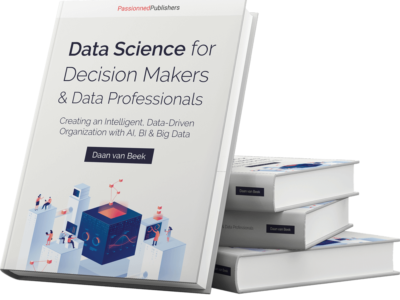When the data says turn left, you turn left, right!?
Data-driven work means that you let the data guide everything you do. So you take actions and make decisions consistently based on data: when the data shows you have to turn left, you turn left. Of course, you also take into account what management wants and what others have to say. But the data and the associated analysis ultimately have the final say. First, we give a definition of data-driven work, and then we show how to set up a data-driven organization. Of course, we also explain key terms so you know what is involved in data-driven work. And we show you how the process of data-driven working works. Passionned Group’s data-driven specialists are happy to help you develop a solid data-driven organization. We wrote a bestseller about it: the Data Science Book.
What is data-driven working? What is data-driven management?
 Data-driven working – also referred to as data-driven management – includes many aspects, both organizational and technical. But first, let’s look at the literal meaning of the term data-driven: driven by data. This means that data guides you and pushes you toward your goal or in the direction you truly need to go. It’s a compelling and fascinating image – keep that in mind. We define data-driven working as follows:
Data-driven working – also referred to as data-driven management – includes many aspects, both organizational and technical. But first, let’s look at the literal meaning of the term data-driven: driven by data. This means that data guides you and pushes you toward your goal or in the direction you truly need to go. It’s a compelling and fascinating image – keep that in mind. We define data-driven working as follows:
Data-driven work is the consistent daily and weekly analysis, decision-making, and steering based on (raw) facts and data. You are guided by data and led by it in your work.
The goal is to gain more insight and knowledge on a daily, weekly, or monthly basis and to make better-informed decisions based on reliable data and insights. The objective is to structurally improve processes within your organization and to foster innovation – across the entire organization. Every employee should be able to work in a data-driven way. But that doesn’t mean everyone has to be, or become, equally data-driven, AI-savvy, or data-literate.
The data-driven architecture
Data-driven architecture does not stand alone. Many concepts come together to shape the development of a simple yet solid data-driven architecture. To truly understand the essence of the term data-driven, you need to be familiar with all of them. Important: we view the concepts of data-driven working and Business Intelligence (BI) as twin sisters – they go hand in hand.
 Figure 1: The concept container as data-driven architecture.
Figure 1: The concept container as data-driven architecture.
At the center of it all is the most important concept: data analysis. A dashboard may show that there’s a problem, but it’s through data analysis that you determine exactly where improvements are needed and where to begin.
Our unique Business Intelligence course can be very helpful in this regard. You’ll learn all aspects of data-driven work and receive a signed copy of the Data Science Book.
Why work in a data-driven way?
 Decisions made in a data-driven way are higher-quality, more rational decisions. They improve profitability, strengthen your financial position, and increase customer satisfaction (Harvard, 2015). Andrew McAfee of MIT even states:
Decisions made in a data-driven way are higher-quality, more rational decisions. They improve profitability, strengthen your financial position, and increase customer satisfaction (Harvard, 2015). Andrew McAfee of MIT even states:
Employees who do not embrace the principle of data-driven work will soon be replaced by those who do.
This applies especially to managers. While it might not be an urgent concern in your organization right now, it’s definitely something to think about. In many organizations, emotion, hierarchy, experience, status, power, and intuition still dominate. And let’s not forget the many biases we all carry as human beings. These factors seriously undermine the quality of decision-making. That’s why data-driven work is a necessity for any organization that wants to operate based on information. Data must be the deciding factor – and yes, sometimes that means going completely against your instincts.
Advantages of data-driven work
 A data-driven organization offers many advantages. Make these benefits your own and develop a vision for your organization – because without that vision, you won’t be able to convince others.
A data-driven organization offers many advantages. Make these benefits your own and develop a vision for your organization – because without that vision, you won’t be able to convince others.
- Much better decisions are made in groups and based on data
- A high degree of transparency that never gets boring – the work becomes less monotonous
- Your employees begin to believe in their work and the mission of the organization again
- A data-driven organization is a learning organization – making mistakes is allowed again
- Your clients experience much better service in a data-driven organization
- Higher profitability and stronger financial position, improved compliance
Try to capitalize on these benefits. You’ll need time – and expertise – to make it happen. We’re happy to help, because our years of experience and high-quality knowledge will certainly pay off.
Organizations that consistently make data-driven decisions see 4% higher productivity and 6% more profit. That might not seem like much, but if you make €1 million in profit, that’s already €60,000. And with that amount, you can already implement a solid system. Source: MIT Center for Digital Business.
Other studies show that successful data-driven work and BI can lead to 33% more satisfied customers. And IoT applications could save the global healthcare sector $63 billion over 15 years. Clearly, the benefits of data-driven working span a wide range of industries.
The Data Science book for Decision Makers & Data Professionals  Every organization can become intelligent - but not without embracing data-driven working at all levels of the business. Our bestselling book, the Data Science Book - with over 25,000 copies sold - shows what that looks like in practice. It describes an organization that is sensitive, smart, agile, and successful, continuously using the right data to spark new waves of improvement. The book provides practical insights for having data-driven processes, increasing agility, and delivering higher-quality service and a better experience to customers.
Every organization can become intelligent - but not without embracing data-driven working at all levels of the business. Our bestselling book, the Data Science Book - with over 25,000 copies sold - shows what that looks like in practice. It describes an organization that is sensitive, smart, agile, and successful, continuously using the right data to spark new waves of improvement. The book provides practical insights for having data-driven processes, increasing agility, and delivering higher-quality service and a better experience to customers.
Data-driven work is a continuous process
A data-driven organization makes decisions on the fly – because there’s far more actionable data available than you might think. Research shows that most organizations use only 1% of the usable data to make better decisions. They tend to focus on the big picture through the rearview mirror and spend too much time justifying instead of steering.
Meanwhile, the pace of change in our society and the world keeps accelerating, meaning you have to make (different) decisions more frequently. And doing so requires increasingly complex data sets. Keep in mind: one political decision or one move by a competitor can wipe out all the major decisions you made over the past year. That’s why it’s so important to collect a lot of external data.
 Figure 2: The process of data-driven work and data-driven decision-making inevitably leads to new knowledge and insights that help you improve your processes exactly where they make the most impact.
Figure 2: The process of data-driven work and data-driven decision-making inevitably leads to new knowledge and insights that help you improve your processes exactly where they make the most impact.
The goal is to build a data-driven organization where everyone makes rational decisions based on data – far more often than before. No more relying solely on gut feeling, assumptions, or opinions. From now on, you operate as a team, with everyone ultimately aligned and moving in the same direction – in line with the organization’s goals, strategy, and mission. Check out our revolutionary approach here: The Data-driven Growth Accelerators™.
What is a data-driven organization?
 A data-driven organization not only looks backward but certainly forward. From accounting to steering to forecasting. A data-driven organization works with static reports, dynamic dashboards, enriching data analytics as well as advanced machine learning. The atmosphere is results-oriented and employees have a can-do mentality because they can always fall back on and feel supported by the data. We define a data-driven organization as follows:
A data-driven organization not only looks backward but certainly forward. From accounting to steering to forecasting. A data-driven organization works with static reports, dynamic dashboards, enriching data analytics as well as advanced machine learning. The atmosphere is results-oriented and employees have a can-do mentality because they can always fall back on and feel supported by the data. We define a data-driven organization as follows:
A data-driven organization is guided by insights from data in everything it does to make better decisions, optimize processes and fine-tune strategy.
But you don’t just lift a data-driven organization off the ground. We wrote an entire book about it: ‘Data Science Book for Decision Makers‘. You have to do a lot of work on four layers:
 Figure 3: The four layers of a data-driven organization.
Figure 3: The four layers of a data-driven organization.
- How do you create a data-driven culture and who takes the lead in it?
- How do you shape a data-driven strategy and where do you invest it?
- How do you get everyone to make data-driven decisions? What BI tools do you use?
- How do you make employees data literate so they are well equipped?
Culture is the hardest thing to reverse. Any way you slice it, it starts at the top of the organization. They must consistently manage or want to make decisions based on reliable numbers.
In addition, data-driven work must become a spearhead for the organization. Give it a place in the business strategy. You don’t just make decisions data-driven, you have to set up a process for that. Finally, train managers and employees until they are sufficiently data literate.
Data-driven solutions
 Working in a data-driven way is very different from building a dashboard (with or without real KPIs) or creating a data warehouse. Technology is of course important but people are the solution! To achieve data-driven management, we are happy to help you practically solve concrete questions such as:
Working in a data-driven way is very different from building a dashboard (with or without real KPIs) or creating a data warehouse. Technology is of course important but people are the solution! To achieve data-driven management, we are happy to help you practically solve concrete questions such as:
- How do you create the right awareness among managers and employees to start working data-driven and how do you steer that change process in the right direction?
- Which aspects of a data-driven organization excel and how do you complete the business case for data-driven work?
- Which decisions in your organization qualify for data-driven management and how do you go about achieving this?
- What types of data – open data, fast data, big data – all form input for data-driven working? What is the best architecture for all these forms of data?
- What risks and pitfalls should you be alert to in data-driven management and what precautions should you take?
- Which BI tools and methodologies are available to implement data-driven management?
Do one or more of these issues also play a role in your organization? Do you want a data-driven organization that acts on facts, steers data-driven and never loses its way? Do you want data-driven work to become meaningful for all employees or the entire management team? Then contact us immediately to organize an inspiration session at your location.
More grip with data-driven processes
Because you get more and much finer insight with data-driven steering, and with great frequency, you can see where your business processes are faltering. The data and dashboards reveal where you should focus your analysis and where you can make adjustments. That’s how you get a better grip on your organization, improve performance and make your processes data-driven. But data science techniques and artificial intelligence can also make an important contribution. Because with a report factory you are often behind the times.
The available tools and solutions
 To shape data-driven work and data-driven management, not only your people are crucial. The right Business Intelligence tools also matter. These come in different shapes and sizes. The solutions that best fit our approach to data-driven steering, data storytelling and our integrated approach are: Qlik, Tableau, Power BI and Visual Analytics from SAS.
To shape data-driven work and data-driven management, not only your people are crucial. The right Business Intelligence tools also matter. These come in different shapes and sizes. The solutions that best fit our approach to data-driven steering, data storytelling and our integrated approach are: Qlik, Tableau, Power BI and Visual Analytics from SAS.
Examples of data-driven organizations
We’ve had the opportunity to help many organizations become more data-driven – from municipalities and emergency services to educational institutions. These real-life examples from our own client work show how powerful data can be in driving change.
But these are not the only sectors where we are active. In addition, we recently helped a health insurance company with the implementation of data-driven working, we provided the business branch of Rabobank, a Dutch bank, with interactive dashboards, we made dashboards for a chain of gas stations, we introduced data-driven working at an elementary school and we advised a telecom company in data-driven steering. Do not wait any longer and also get to know the Passionned Group consultants: together we achieve success with data. Knock on our digital door for more information or book an appointment right away.
Roadmap: 5 steps to data-driven decisions
Want to get started quickly with data-driven work? Then we have created a concise roadmap here. Make data-driven working part of your organization’s DNA in 5 steps.
- Make your goals measurable & SMART. If you’re data-driven, then you’re going to set goals SMART. For example, 10 percent increase in your customer satisfaction within one year. This way you force yourself to analyze both your successes and failures. Only with data will you prove what went wrong or right and improve your performance as a continuous process. Try to make what you do as measurable as possible. Not only at the management level but precisely for everyone. Even personal goals and smaller projects. This will give everyone insight into what they are doing and the feeling that they are contributing to your organization. Reward employees and departments when they meet their goals.
- Collect lots and variety of data. You often already own a load of data without knowing it. Organize that according to a model. Then start actively and consciously collecting data. Think of internal sources such as the ERP system, the case system, AFAS, Google Analytics, SalesForce or other customer information. But don’t forget external sources such as social media and information about your competitors or colleagues. In addition to a lot of data, it is equally important to have varied data from different departments. For example, service quality, customer feedback, reviews, speed of delivery and the effectiveness of marketing campaigns. Make sure all your departments within the company are asking the right questions to get the correct data.
- Take the customer or citizen as the starting point. Many organizations think from the product rather than from their customer. If you want to be a true data-driven organization, you change your way of thinking. You put your customer at the center. Engage in the conversation. Make it a dialogue instead of a one-way street. Balance your data with innovation and creativity to create a more relevant experience, product and/or service for your customers. But to do this, data must be widely available within your company. You can achieve this with business intelligence and BI software.
- Make data accessible to everyone. The biggest danger is that data stays only with your IT or marketing department. This is a waste. You want everyone to have access to the data they need to do their jobs well. From accountants to your planners. After all, with that information, departments align their priorities with those of your customer. They see what’s important and further align their service and operations accordingly. In many companies, this means a real culture change. Therefore, appoint someone from your management team with authority. A champion of open data and data-driven decisions. And let’s face it: some people understand data better than others. Fortunately, this is why you train your employees in reading and analyzing data. In this way, every employee becomes data literate. By doing so, you empower them to make data-driven and therefore informed decisions on their own or as a team.
- Engage the right people and put the experts to work. To make the most of the data you have, you need experts. Those are data scientists and data analysts. They build complex algorithms and analyses and find the right information in a sea of zeros and ones. They not only need to understand data, but also show genuine interest in your company, market and strategy. Someone who proactively thinks along about what other data sources you need, what the customer needs are and how to use your data for this purpose. Moreover, you want everyone to be able to see the data easily and quickly. The foundation of your data-driven organization.
Big steps, fast home? Indeed, these are the outlines. Do you really want to know the ins and outs? Download our good-new white paper ‘The 101 steps to BI success‘.
Quick wins and important principles
To make a turnaround a success, we recommend focusing on a few easy quick wins at the start. Try to identify 3 to 5 of them. That way, you immediately create enthusiasm and energy for further change. Always adhere to the following principles:
- Collect enough and the right data
- Let that flow throughout your organization
- Data is available everywhere and to everyone
- Data is fast and easy to read
Do you also want more profits, higher productivity and a happy customer? Then make the move to a data-driven organization now.
Become an expert in data-driven work
 Don’t let anyone tell you anything and delve deeper into the beautiful field of data-driven working here. Click on one of the links below and a whole new world might just open up for you.
Don’t let anyone tell you anything and delve deeper into the beautiful field of data-driven working here. Click on one of the links below and a whole new world might just open up for you.
Get data-driven management in your organization now, order the big data & AI book here and improve and sustain your business processes.
Do you also want to get started with data-driven steering?
Do you want to achieve a data-driven organization and implement data-driven work into the capillaries of your organization? Do you want to avoid the most common pitfalls and achieve data-driven success? Contact one of our data-driven specialists immediately.
About Passionned Group
 We are the specialist in data-driven working, BI & AI. Our passionate and experienced hands-on consultants and advisors help larger and smaller organizations in the transition to an intelligent, data-driven organization. Every other year we organize the Dutch BI & Data Science Award™.
We are the specialist in data-driven working, BI & AI. Our passionate and experienced hands-on consultants and advisors help larger and smaller organizations in the transition to an intelligent, data-driven organization. Every other year we organize the Dutch BI & Data Science Award™.
Frequently Asked Questions
What does data-driven work require from managers?
The will to consistently manage based on insights and reliable data. And to bring the team along with them. Finally, an analytical view and attitude.
Is my corporate culture ready for data-driven management?
Yes, precisely because with data-driven steering you also start working with raw data, the culture of your company does not matter much at first. Our years of experience in realizing data-driven organizations and data-driven processes make it clear time and again that you can apply our approach in any company culture and in any sector. Provided, of course, that the data is available and you will act accordingly.
How can you learn to work data-driven?
Figure out what decisions you make and what insights you need to make an optimal decision. Then find the data to go with it. Of course, this is easier said than done. Want to learn more about this? Then take a look at our in-depth framework ‘Data-driven working’.
Is data-driven work difficult?
Basically, it is easy (see the process), but to implement it in an organization is quite a task. After all, not every manager and employee has the right skills and competencies. There are also often challenges in accessing the data. And data quality also often leaves much to be desired.
What is the core of data-driven work?
Peering at a dashboard with KPIs or peering at a graph makes no difference. You have to initiate and execute data analyses when there are (large) deviations of the KPI scores from the norm. That way you can quickly figure out what the problem is that needs to be fixed.
Are there any drawbacks to a data-driven organization?
Certainly, the more transparency the greater the chance of intervention from outside or above. And that is certainly not desirable in all cases. By measuring everything loose and loose, you probably also destroy creativity and innovation in your organization.
How do I determine the right KPIs for my organization?
Several methods can help you with this: decision-driven, strategy-driven, process-driven or data-driven. Read more about the methods and setting up KPIs in our SMART KPI Guide 2025.
Data-driven work vs information-driven work, is there a difference?
There is actually no fundamental difference, but data-driven working is usually associated with technology (BI, AI) and information-driven working with managerial steering based on data and information.

 Together with the emergency room, ambulance services and a team of cardiologists from the various hospitals, the Noord-Holland-Noord Safety Region developed a process dashboard based on data-driven work. They wanted to know how their cardiac patients with an acute heart problem were being guided through the entire care chain and what improvements they could make in that process.
Together with the emergency room, ambulance services and a team of cardiologists from the various hospitals, the Noord-Holland-Noord Safety Region developed a process dashboard based on data-driven work. They wanted to know how their cardiac patients with an acute heart problem were being guided through the entire care chain and what improvements they could make in that process.
